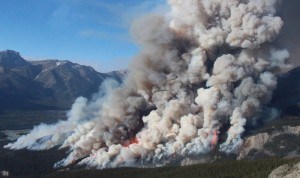
If you’re planning a trip down Highway 93, be sure to hit the road early to avoid road closures caused by the Spreading Creek wildfire in Banff National Park.
To protect motorists, as well as Parks Canada staff, the highway will be closed during the heat of the day when fire activity is at its peak.
“The best time for travel is between 7 a.m. and 2 p.m.,” said Rick Kubian, Parks Canada’s incident commander. “That doesn’t mean the highway will be closed at 2 p.m., it means that that’s when fire behaviour usually picks up.
“So for folks trying to get through, it’s best to travel before 2 p.m.”
Although fire crews are doing their best to keep the highway open, motorists traveling after 2 p.m. have a higher risk of being turned around, said Kubian.
The Spreading Creek fire ignited following a lightning strike July 3 and has since consumed 2,500 hectares of land within Banff National Park and an additional 4,500 hectares northeast of the park boundary.
“The lightning struck right on the Banff park boundary, northeast of the Saskatchewan River Crossing, and in the subsequent days the primary spread was in the province of Alberta, then on July 9th or 10th it moved back into Banff National Park,” said Kubian.
Initially, the province and Parks Canada were working “in unified command, which means we were working as one operation,” said Kubian. But, as the fire spread to the east and west, the command was split, with two separate operations taking place in cooperation with one another.
On Monday, Kubian said the scene was fairly quiet, following some major fire operations that took place over the weekend.
“The day before yesterday (Saturday) we used aerial ignition to burn out an area to bring the fire to a steep rocky creek drop and to Highway 93 North. Those are two anchors that we hope we can contain the fire with in the next 72 hours or thereabouts.”
Although the fire was considered contained on Monday, travel delays on Highway 93 can be expected for the next six to eight weeks, as the forest conditions are currently very dry from weeks of hot weather, with little to no precipitation.
It’s that weather that has “brought us rapidly to this scenario,” said Kubian, who has 40 fire personnel and five helicopters fighting the fire on the park side.
Two members of Jasper’s fire crew—Landon Shepherd and Randy Fingland—have assisted in the response and Fingland was still in Banff on Monday.
Like Banff, Jasper’s fire danger is also extreme, so, according to Kim Weir, Jasper National Park’s fire communications officer, the park’s fire crew is on standby waiting to jump into action at anytime.
“Because we’re in such extreme fire danger right now we have to stay manned up and on high alert, so we have our initial attack crew and our fire duty officer and an incident management team on standby, as well as two helicopters, so we’re geared up here, too.”
So far this month, Jasper has had two small wildfires in the northeast corner of the park, near the border with Willmore Wilderness Park. Each were less than 5,000 square metres—about half a hectare—in size.
Weir said one is extinguished, while the other still has the potential to reignite.
“The only reason we’re not calling the second one extinguished is because of the fire danger and the insanely dry conditions right now.
“It’s pretty much extinguished, but we don’t want to say it’s extinguished and then have a little hot spot spark up again.”
Parks is continuing to monitor the area to ensure that doesn’t happen.
And, in the meantime, the rain in the forecast is welcomed—although it’s not likely enough to decrease the fire threat.
“It will take a significant amount of precipitation to bring us out of fire danger for any period of time,” said Weir. “I was talking to Clayton [Anderson], the fire duty officer for Jasper, and he said maybe 10 millimetres might bring us out of it for a week, at most.”
For up to date road information, visit www.511.ab.ca.
Nicole Veerman
[email protected]
